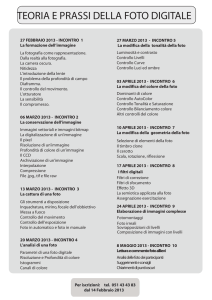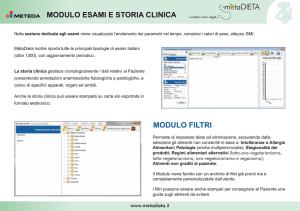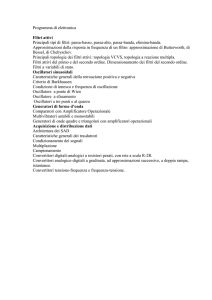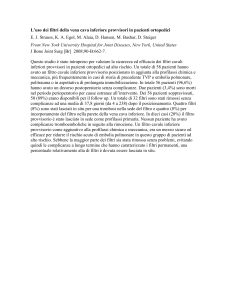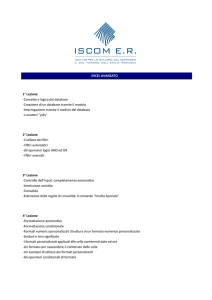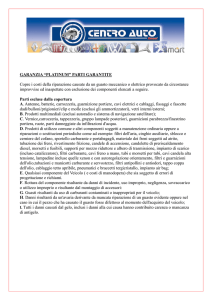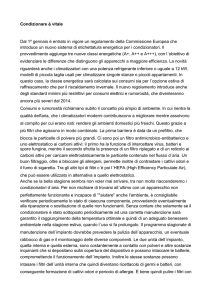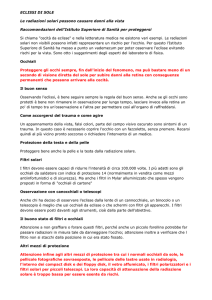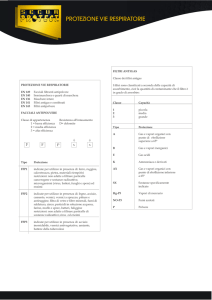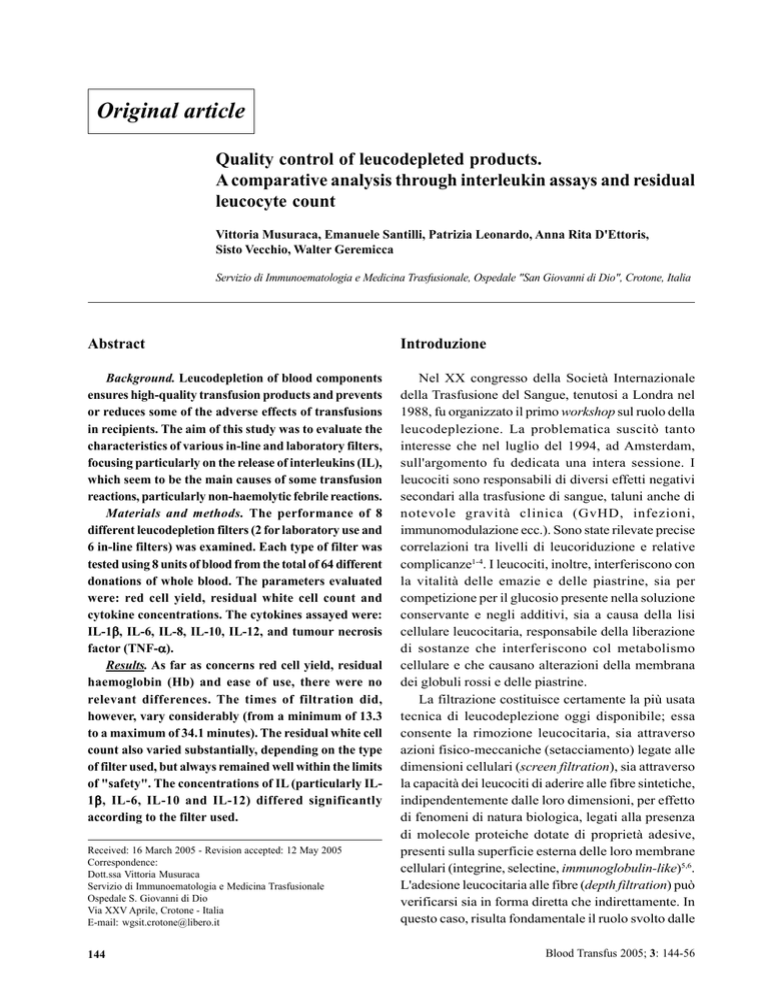
Original article
Quality control of leucodepleted products.
A comparative analysis through interleukin assays and residual
leucocyte count
Vittoria Musuraca, Emanuele Santilli, Patrizia Leonardo, Anna Rita D'Ettoris,
Sisto Vecchio, Walter Geremicca
Servizio di Immunoematologia e Medicina Trasfusionale, Ospedale "San Giovanni di Dio", Crotone, Italia
Abstract
Introduzione
Background. Leucodepletion of blood components
ensures high-quality transfusion products and prevents
or reduces some of the adverse effects of transfusions
in recipients. The aim of this study was to evaluate the
characteristics of various in-line and laboratory filters,
focusing particularly on the release of interleukins (IL),
which seem to be the main causes of some transfusion
reactions, particularly non-haemolytic febrile reactions.
Materials and methods. The performance of 8
different leucodepletion filters (2 for laboratory use and
6 in-line filters) was examined. Each type of filter was
tested using 8 units of blood from the total of 64 different
donations of whole blood. The parameters evaluated
were: red cell yield, residual white cell count and
cytokine concentrations. The cytokines assayed were:
β, IL-6, IL-8, IL-10, IL-12, and tumour necrosis
IL-1β
α).
factor (TNF-α
Results. As far as concerns red cell yield, residual
haemoglobin (Hb) and ease of use, there were no
relevant differences. The times of filtration did,
however, vary considerably (from a minimum of 13.3
to a maximum of 34.1 minutes). The residual white cell
count also varied substantially, depending on the type
of filter used, but always remained well within the limits
of "safety". The concentrations of IL (particularly ILβ , IL-6, IL-10 and IL-12) differed significantly
1β
according to the filter used.
Nel XX congresso della Società Internazionale
della Trasfusione del Sangue, tenutosi a Londra nel
1988, fu organizzato il primo workshop sul ruolo della
leucodeplezione. La problematica suscitò tanto
interesse che nel luglio del 1994, ad Amsterdam,
sull'argomento fu dedicata una intera sessione. I
leucociti sono responsabili di diversi effetti negativi
secondari alla trasfusione di sangue, taluni anche di
notevole gravità clinica (GvHD, infezioni,
immunomodulazione ecc.). Sono state rilevate precise
correlazioni tra livelli di leucoriduzione e relative
complicanze1-4. I leucociti, inoltre, interferiscono con
la vitalità delle emazie e delle piastrine, sia per
competizione per il glucosio presente nella soluzione
conservante e negli additivi, sia a causa della lisi
cellulare leucocitaria, responsabile della liberazione
di sostanze che interferiscono col metabolismo
cellulare e che causano alterazioni della membrana
dei globuli rossi e delle piastrine.
La filtrazione costituisce certamente la più usata
tecnica di leucodeplezione oggi disponibile; essa
consente la rimozione leucocitaria, sia attraverso
azioni fisico-meccaniche (setacciamento) legate alle
dimensioni cellulari (screen filtration), sia attraverso
la capacità dei leucociti di aderire alle fibre sintetiche,
indipendentemente dalle loro dimensioni, per effetto
di fenomeni di natura biologica, legati alla presenza
di molecole proteiche dotate di proprietà adesive,
presenti sulla superficie esterna delle loro membrane
cellulari (integrine, selectine, immunoglobulin-like)5,6.
L'adesione leucocitaria alle fibre (depth filtration) può
verificarsi sia in forma diretta che indirettamente. In
questo caso, risulta fondamentale il ruolo svolto dalle
Received: 16 March 2005 - Revision accepted: 12 May 2005
Correspondence:
Dott.ssa Vittoria Musuraca
Servizio di Immunoematologia e Medicina Trasfusionale
Ospedale S. Giovanni di Dio
Via XXV Aprile, Crotone - Italia
E-mail: [email protected]
144
Blood Transfus 2005; 3: 144-56
Quality control of leucodepleted products
Conclusions. Although no differences of note were
found between the filters for many characteristics, the
IL concentrations demonstrated that filters with an
electrically charged surface (whether positive or
negative) tend to cause greater release of inflammatory
cytokines, albeit rarely to the extent of being able to
induce adverse reactions in the recipients of the filtered
units.
Key words : interleukins, leucodepletion, quality control,
filtered products
Introduction
The first workshop on the role of leucodepletion
was organized at the XX Congress of the International
Society of Blood Transfusion held in London in 1988.
The issue raised such interest that in July 1994, in
Amsterdam, a whole session was devoted to
leucodepletion. White blood cells are responsible for
various negative side effects of blood transfusion
(graft-versus-host
disease,
infections,
immunomodulation, etc.), which can sometimes be
of very considerable clinical severity. Precise
correlations have been found between the levels of
leucoreduction and the related complications 1-4.
Furthermore, white blood cells influence the viability
of the red blood cells and platelets, both by competing
for the glucose present in the storage solution and
additives, and because of leucocyte lysis, which causes
the release of substances that affect cell metabolism
and provoke changes in the membranes of red blood
cells and platelets.
Filtration is certainly the most widely used
technique currently available for leucodepletion; this
procedure removes the white cells either by physicomechanical mechanisms (sieving) based on the size
of the cells (screen filtration) or by exploiting the
capacity of white cells, independently of their size, to
adhere to synthetic fibres through natural biological
phenomena involving proteins with adhesive
properties on the external surface of their cell
membranes (integrins, selectins, immunoglobulin-like
proteins) 5,6. Leucocyte adhesion to fibres (depth
filtration) can occur both directly and indirectly. In
the latter case the role played by the platelets is
fundamental, since these bind to the fibres through
their own adhesions molecules and subsequently
Blood Transfus 2005; 3: 144-56
piastrine, le quali si legano alle fibre mediante loro
molecole di adesione di membrana e,
successivamente, diventano substrato per la adesione
dei leucociti. A tale proposito, sono state rilevate
differenze di comportamento delle varie popolazioni
cellulari leucocitarie: i linfociti vengono rimossi
principalmente per setacciamento, i monociti per
adesione diretta, i granulociti per adesione mediata
dalle piastrine7,8.
Oggi sono disponibili filtri per leucodeplezione
composti da fibre con diversa carica elettrica di
superficie. In alcuni di questi è stata rilevata la
presenza di attività enzimatiche serin-proteasiche,
probabilmente secondarie alla attivazione della cascata
coagulativa della cosiddetta fase di contatto. Questo
sembra essere alla base della comparsa, a distanza di
tempo non superiore a una ora dalla trasfusione, di
tachicardia e ipotensione, in qualche caso anche di
grave entità, specialmente nei pazienti in terapia con
farmaci ACE-inibitori. Un ruolo sempre più
importante assume oggi la filtrazione pre-storage, la
quale prevede che tale metodica venga condotta entro
24 ore dal prelievo. In questo modo si impedisce il
passaggio di leucociti vitali, con membrane cellulari
e organuli intracellulari integri, prevenendo così la
frammentazione cellulare responsabile della
liberazione di mediatori pro-infiammatori e della
formazione di microaggregati9-14. Negli ultimi anni
viene data sempre maggiore importanza alla
liberazione delle interleuchine (IL) intracellulari,
relativamente alla comparsa di reazioni posttrasfusionali non emolitiche15-18.
Scopo di questo lavoro è esaminare la capacità
leucodepletiva, la manualità, la resa e la velocità di
filtrazione di alcuni dei filtri, sia in linea che da
laboratorio, in commercio in Europa. Inoltre, si vuole
verificare se la filtrazione di per sé possa determinare
un incremento della concentrazione di talune citochine
proinfiammatorie potenzialmente responsabili di
alcuni effetti collaterali post-trasfusionali
indesiderabili.
Materiali e Metodi
Sono stati utilizzate 64 donazioni di sangue, da
donatori periodici idonei alla donazione al momento
del prelievo, condotte secondo la prassi normale,
selezionando unità il più possibile vicine agli standard
medi di Ht, Hb e conta leucocitaria. Si sono testate
145
V Musuraca et al.
become the substrate for the adhesion of the
leucocytes. Differences have been found in the
behaviour of the various white cell populations:
lymphocytes are removed mainly by sieving,
monocytes by direct adhesion, granulocytes by
platelet-mediated adhesion7,8.
The leucodepletion filters currently available are
made of fibres with different surface electrical charges.
Some of these filters have been found to cause
serine-protease enzymatic activity, probably
secondary to activation of the coagulation cascade of
the so-called contact phase. This phenomenon seems
to be at the basis of the development of tachycardia
and hypotension within less than an hour of the
transfusion. In some cases, especially in patients
receiving ACE-inhibitor treatment, these side effects
can be very severe. Pre-storage filtration is currently
gaining an increasingly important role. This method
of filtration is carried out within 24 hours the blood
being collected. In this way the passage of viable
leucocytes, with intact intracellular organelles and cell
membranes, is prevented: this avoids the risk of the
cellular fragmentation, that is responsible for releasing
pro-inflammatory mediators and the formation of
microaggregates 9-14. In recent years the release of
intracellular interleukins (IL) has been attributed
increasing importance as being involved in the
development of non-haemolytic post-transfusional
reactions15-18.
The aim of this study was to examine the efficacy
of leucodepletion, the ease of use, the yield and the
speed of filtration of some in-line and laboratory white
blood cell filters commercially available in Europe.
Another aim was to determine whether filtration itself
could cause an increase in the concentration of various
pro-inflammatory cytokines potentially responsible
for some post-transfusional side effects.
Materials and Methods
Sixty-four units of donated blood were used. These
units had been collected from periodic donors who
were fit for donation at the time of the collection,
which was carried out according to normal practices.
The units were selected for having values of
haematocrit, haemoglobin and white cell count as
close as possible to the standard mean. Eight units
were used to test each of the following filters
commercially available in Europe: the laboratory
146
otto unità per ciascuno dei seguenti filtri disponibili
sul mercato europeo: filtri da laboratorio Imugard III
RC (Terumo Italia, Roma. Italia) e Leucolab LCG 2
(Maco Pharma Italia, Rho, MI, Italia); filtri in linea
R7546 (Baxter Fenwal, Roma, Italia), Leucored RC/
PL SK (Grifols Italia, Ghezzano, PI, Italia), RCT
434CL (Pall Italia, Milano, Italia), T3945 (Fresenius
HemoCare, Midolla, MO, Italia), LPT6265LR (Maco
Pharma), BB*WGQ45613 (Terumo). Le procedure
di filtrazione sono state condotte secondo le
raccomandazioni delle ditte produttrici dei filtri e delle
sacche con filtri in linea. In tutti i casi si è adottata
uniformità di condotta con particolare riferimento alla
temperatura di filtrazione (18-22 °C), tempi di
filtrazione e manualità di esecuzione. In tutte le sacche
è stata effettuata conta leucocitaria pre-filtrazione e
post-filtrazione e dosaggio interleuchinico postfiltrazione. La filtrazione con i filtri da laboratorio ha
avuto luogo entro cinque giorni e, con i filtri in linea,
entro 24 ore dal prelievo. In tutti i casi la conta prefiltrazione ha avuto luogo entro 6 ore dal prelievo,
mentre la conta post-filtrazione è stata condotta entro
le 24 ore dalla filtrazione. Sul prodotto finale si è
rilevato il peso della sacca filtrata, l'emocromo della
stessa e il peso del filtro post-filtrazione. Il tempo di
filtrazione è stato calcolato partendo dal momento
della rottura delle valvole, che permettono il deflusso
del sangue verso il filtro, fino al momento in cui non
era più visibile alcun flusso di sangue dal filtro alla
sacca di raccolta. La filtrazione è stata eseguita su
emazie concentrate prive di buffy-coat, tranne che per
le sacche Grifols, Terumo e Fresenius, le cui
configurazioni permettono la filtrazione di sangue
intero, prima del frazionamento in emazie, buffy-coat
e plasma ricco di piastrine (PRP).
I dosaggi di controllo per le interleuchine IL-1β,
IL-6, IL-8, IL-10, IL-12 e TNF-α sono stati eseguiti
su dodici raccolte da donatori periodici, idonei alla
donazione al momento del prelievo; i dosaggi sono
stati eseguiti su plasma ottenuto da sacche di globuli
rossi concentrati (GRC) prive di buffy-coat, a distanza
di 3, 6, 24 ore e 3, 10, 20 giorni dal prelievo.
I dosaggi delle IL sopramenzionate nei prodotti di
filtrazione sono stati eseguiti su campioni di plasma
ottenuti immediatamente dopo la filtrazione.
Sia la conta leucocitaria sia il dosaggio
interleuchinico sono state ottenute mediante
citofluorimetria 19 , col FACSCalibur (Becton
Dickinson Italia, Milano, Italia), secondo le
indicazioni fornite dalla ditta, per l'uso rispettivamente
Blood Transfus 2005; 3: 144-56
Quality control of leucodepleted products
Table I - Filters tested in the study
A
B
C
D
E
F
G
H
Maco Pharma LPT6265LR
Baxter
Pall
Fresenius
Terumo BB*WGQ45613
Grifols
Imugard Terumo
Maco Pharma Leucolab
Table II - Post-filtration yield and times necessary for filtration
A
B
C
D
E
F
G
H
WEIGHT OF FILTERED
RED CELLS (grams)
MEAN
RESIDUE IN FILTER
(grams)
MEAN
HAEMOGLOBIN
(grams)
MEAN
TIME OF FILTRATION
(minutes)
MEAN
237±11.1
251±9.2
248±6.4
237±5.6
247±7.3
241±3.4
233±6.0
222±16.4
28.4±4.7
22.6±2.5
20.4±3.1
22.4±6.3
21.3±5.2
20.4±4.9
20.2±4.8
19.4±3.7
49.6±3.4
52.4±1.9
51.8±2.8
49.7±3.1
50.1±2.6
51.3±2.1
46.8±2.3
44.7±3.8
34.1±4.7
22.6±1.8
20.3±2.5
25.4±3.1
28.2±2.0
22.7±4.1
13.3±1.6
21.6±3.3
filters Imugard III RC (Terumo Italia, Rome, Italy)
and Leucolab LCG 2 (Maco Pharma Italia, Rho, MI,
Italy) and the in-line filters R7546 (Baxter Fenwal,
Rome, Italy) Leucored RC/PL SK (Grifols Italia,
Ghezzano, PI, Italy), RCT 434CL (Pall Italia, Milan,
Italy) T3945 (Fresenius HemoCare, Midolla, MO,
Italy),
LPT6265LR
(MacoPharma)
and
BB*WGQ45613 (Terumo). In all cases the filtration
procedures was carried out according to the
instructions provided by the manufacturers of the
filters and the bags with in-line filters. Furthermore,
all the filtrations were carried out in uniform
conditions of temperature (18-22 °C), time and
handling. Pre-filtration and post-filtration white cell
counts were measured in all the bags and cytokine
concentrations were assayed post-filtration. The
filtration with laboratory filters was done within five
days, where as the in-line filtration was done within
24 hours of the collection. In all cases the pre-filtration
white cell count was determined within 6 hours of
the donation, while the post-filtration count was
evaluated within 24 hours of the filtration. Other
measurements were the weight of the filtered bag, its
full blood count and the weight of the filter following
filtration. The time required for the filtration was
calculated from the moment of opening the valves,
that allow the blood to flow towards the filter, until
the moment that there was no longer any visible blood
Blood Transfus 2005; 3: 144-56
del Kit LeucoCOUNT System e dell'Human
Inflammation Kit. I risultati ottenuti sono stati
analizzati statisticamente mediante il calcolo della
media, come indice di localizzazione, e della
deviazione standard, come indice di dispersione.
Risultati
La tabella I mostra la trascodifica dei filtri utilizzati
in questo studio.
L'analisi di alcuni parametri quali il residuo, la resa
in emazie concentrate, il contenuto in grammi di
emoglobina delle sacche filtrate e il tempo necessario
per la filtrazione, pur con alcune minime variazioni,
non ha riscontrato differenze sostanziali tra i filtri
esaminati: la resa varia dai 222 grammi del filtro H ai
251 grammi del filtro B. Il residuo dai 19,4 grammi
del filtro H ai 28,4 grammi del filtro A. La quantità di
emoglobina dai 44,7 grammi del filtro H ai 52,4
grammi del filtro B.
Il tempo di filtrazione varia dai 13,3 minuti del
filtro G ai 34,1 minuti del filtro A (Tabella II). Nell'
uso corrente dei filtri in esame non si sono rilevate
differenze di rilievo nella manualità; le differenze sono
piuttosto dovute alla diversa conformazione delle
sacche.
L'analisi della conta leucocitaria residua dimostra
come con tutti i filtri testati si sono ottenute conte
147
V Musuraca et al.
A
B
C
D
E
F
G
H
RESIDUAL COUNT
500000
443735
429000
400000
150,000 ± 61,801
39,150 ± 47,478
46,250 ± 40,735
443,735 ± 367,728
429,000 ± 376,836
202,000 ± 73,485
124,778 ± 145,662
137,350 ± 230,035
300000
200000
170200
150000
146250
124778
137350
100000
39150
0
A
B
C
D
E
F
G
H
Figure 1 - Residual post-filtration white blood cell count (mean ± SD)
flow from the filter to the collection bag. The filtration
was carried out on red cell concentrates without the
buffy-coat, except for the Grifols, Terumo and
Fresenius bags whose systems allow filtration of
whole blood before fractionation into red cells, buffycoat and platelet-rich plasma. The control assays for
IL-1β, IL-6, IL-8, IL-10, IL-12 and TNF-α were
carried out on bags from twelve periodic donors, fit
for donation at the moment of the collection; the assays
were performed on plasma obtained from bags of red
cell concentrate from which the buffy-coat had been
removed, at 3, 6, and 24 hours and 3, 10, and 20 days
after the collection. In the filtered products, the
abovementioned cytokine assays were performed on
samples of plasma obtained immediately after
filtration. Both the white cell count and the cytokine
concentrations were determined by flow cytometry19,
with a FACSCalibur (Becton Dickinson Italia, Milan,
Italy), according to the manufacturers' instructions for
the use of the Kit LeucoCOUNT System and the
Human Inflammation Kit, respectively.
The statistical analysis of the results was performed
by calculating the mean, as the index of localisation,
and the standard deviation, as the index of dispersion
of the data.
Results
Table I shows the codes used for the filters
investigated in this study. The analysis of some of the
148
leucocitarie post-filtrazione decisamente inferiori ai
parametri considerati "di sicurezza" (pari a 1x106): in
tre casi di filtri in linea si sono ottenuti valori medi
oscillanti tra 4 e 2x105), in tutti gli altri inferiori a
1.5x105 (Figura 1) .
Considerando che le unità di partenza avevano un
contenuto medio di leucociti pari a circa 1,5x109 (peso
medio per contenuto medio di leucociti) e
considerando che la conta leucocitaria residua media
era pari a 2,0x105, la leucodeplezione media calcolata
è risultata pari a 0,75x10 4, ovvero oltre quatto
logaritmi.
Per quanto riguarda il dosaggio delle IL nei
controlli, si è evidenziato che per il TNF-α e per la
IL-10 non si sono trovati valori quantitativamente
rilevanti. Per la IL-1β, si è registrata una progressiva
riduzione dei valori, dal prelievo al terzo giorno di
conservazione; in seguito, fino al decimo giorno, si è
verificato un netto decremento (Figura 2).
Per IL-6, IL-8, IL-12 si nota un lieve incremento
dal momento del prelievo fino alla 24a ora, per poi
rapidamente ridursi entro il 10 giorno di
conservazione. I dosaggi delle IL nei prodotti di
filtrazione hanno dato i risultati riportati di seguito:
β . La filtrazione con i filtri A, B, E, G non ha
IL-1β
determinato aumento della sua concentrazione,
rispetto ai controlli; nel caso dei filtri C, D, F, H, invece
si sono verificati netti aumenti di concentrazione nei
prodotti filtrati (Figura 3).
IL-6. Nelle sacche filtrate con i filtri A,B, G e H
non si sono trovate quantità di IL-6 dosabili col nostro
Blood Transfus 2005; 3: 144-56
Quality control of leucodepleted products
IL-1β
IL-6
IL-8
IL-10
IL-12
TNF-α
3 hours
6 hours
24 hours
3 days
10 days
20 days
44.05 ± 36.56
0.00
4.95 ± 0.49
4.15 ± 0.07
6.35 ± 1.48
2.85 ± 0.35
31.90 ± 5.24
11.00 ± 1.12
9.30 ± 0.57
4.10 ± 0.94
11.60 ± 8.20
2.00 ± 0.36
26.65 ± 14.35
10.60 ± 2.57
10.16 ± 14.31
4.55 ± 1.34
16.20 ± 23.05
3.7 0± 0.65
27.20 ± 6.19
1.50 ± 0.63
3.10 ± 1.15
3.80 ± 2.40
8.70 ± 2.7
2.60 ± 0.99
0.00
0.00
3.72 ± 0.88
1.80 ± 0.78
0.00
2.20 ± 1.02
0.00
1.70 ± 0.83
4.70 ± 1.46
2.05 ± 0.49
0.00
1.90 ± 0.34
Figure 2 - Interleukin concentrations in controls. Values in the table are means ± SD expressed in pg/mL
IL 6
IL-1ÿ
45,00
250,00
40,00
200,00
35,00
30,00
150,00
25,00
20,00
100,00
15,00
50,00
10,00
5,00
0,00
0,00
K
K
A
B
C
D
E
F
G
H
A
B
C
D
E
F
G
H
26.65 ± 14.35
28.60 ± 24.20
22.20 ± 6.68
99.45 ± 11.3
107.75 ± 54.38
38.30 ± 33.80
194.00 ± 7.40
30.17 ± 9.10
89.80 ± 19.60
MEAN ± S.D.
Figure 3 - Concentrations of IL 1β; the K column represents the
mean of the values measured in the control bags 24 hours
after collection; the horizontal line indicates the mean
level in the controls. The table shows means ± SD
Blood Transfus 2005; 3: 144-56
K
K
A
B
C
D
E
F
G
H
A
B
C
D
E
F
G
H
10.60 ± 2.57
0.00
0.00
4.10 ± 1.30
18.55 ± 1.80
39.00 ± 3.40
8.80 ± 0.90
0.00
0.00
MEAN ± S.D.
Figure 4 - Post-filtration concentrations of IL-6 (The table
shows means ± SD)
149
V Musuraca et al.
parameters, such as residue, yield of red cell
concentrate, haemoglobin content (in grams) of the
filtered bags and the time necessary for filtration
showed that although there were some minimal
variations, there were no substantial differences in
these performance characteristics of the filters
investigated: the yield ranged from 222 grams with
filter H to 251 grams with filter B. The residue ranged
from 19.4 grams with filter H to 28.4 grams for filter
A. The amount of haemoglobin varied from 44.7
grams with filter H to 52.4 grams with filter B. The
filtration time ranged from 13.3 minutes for filter G
to 34.1 minutes for filter A (Table II). With the current
use of the filters under examination there were not
substantial differences in handling; rather, differences
were due to the different conformations of the bags.
The analysis of the residual white cell count
showed that all the filters tested produced postfiltration leucocyte counts well below the so-called
level of "safety" (that is, 1x106): in three cases in-line
filters gave mean values ranging between 4 x105 and
2x105), in all the other cases the values were below
1.5x105 (Figure 1). Considering that the starting units
had a mean leucocyte count of about 1.5x109 (mean
weight for mean content of leucocytes) and
considering that the mean residual leucocyte count
was 2.0x105, the mean calculated leucodepletion was
0.75x104, or more than four log.
As far as concerns the cytokine assays in the control
samples, quantitatively relevant amounts of TNFα and IL-10 were not found. The concentration of
IL-1β decreased gradually from the time of collection
until the third day of storage; from then on until the
tenth day there was a very sharp drop (Figure 2). The
concentrations of IL-6, IL-8 and IL-12 rose slightly
during the first 24 hours after the collection and then
decreased quickly within the 10 days of storage.
The results of the cytokine assays in the filtration
products were as follows.
β. Filtration with filters A,B,E, and G did not
IL-1β
cause any increase in the concentration of this IL over
the concentration in control samples; in contrast,
filtration through filters C, D, F, and H produced a
clear increase in the concentration of IL-1β in the
filtered products (Figure 3).
IL-6. Any IL-6 present in bags filtered with filters
A,B, G and H was below the detection limit of our
assay, whereas when filters D and E were used, higher
concentrations of IL-6 were found in the filtered bags
than in the control bags (Figure 4).
150
metodo di indagine, mentre in quelle filtrate con i filtri
D e E si sono trovate quantità maggiori rispetto ai
controlli (Figura 4).
IL-8. Nei prodotti di filtrazione ottenuti con i filtri
A,B,G si sono trovate concentrazioni decisamente
minori rispetto ai controlli; invece in quelli ottenuti
con i filtri E e F abbiamo trovato concentrazioni
superiori (Figura 5).
IL-10 e IL-12. Per le interleuchine IL-10 e IL-12,
solamente nel caso delle sacche filtrate con il filtro E
si è trovato un notevole aumento della loro
concentrazione (Figure 6 e 7 ).
TNF-α. Per il TNF-α, in nessun caso si sono
rilevate concentrazioni rilevanti nelle sacche filtrate
esaminate (Figura 8).
Discussione
La scelta dei campioni da sottoporre alla nostra
analisi è stata guidata dalla necessità di testare unità
di sangue intero il più possibile simili tra loro in
termini di Ht (da un minimo di 43,8% ad un massimo
di 45,2 %), contenuto emoglobinico per unità (da 65,2
a 72,2 g) e conta leucocitaria (da 5.200 a 6.300
leucociti/µL), allo scopo di ridurre al minimo le
interferenze dovute alle differenze di partenza, nella
valutazione della resa post-filtrazione e della capacità
leucodepletiva dei singoli filtri. Nonostante le
inevitabili differenze, in tutti i casi i prodotti finali si
sono dimostrati del tutto rispondenti agli standard
richiesti dai protocolli internazionali1,4.
I dosaggi delle citochine nei controlli hanno
evidenziato valori superiori ai 25 pg/µL solo per la
IL-1β dalla terza ora al terzo giorno di distanza dal
prelievo; per tutte le altre citochine si sono sempre
trovate concentrazioni inferiori ai 20 pg/µL. Dosaggi
così bassi, però, possono essere dovuti a diversi
meccanismi biologici capaci di interferire con la loro
corretta titolazione nel comparto extracellulare: il
fisiologico re-uptake molecolare, ad esempio, oppure
la compartimentalizzazione intracellulare, oppure
l'adsorbimento di talune citochine sulle membrane
eritrocitarie. Sono state descritte, infatti, affinità di
talune citochine, in particolare la IL-8, per gli antigeni
eritrocitari responsabili della specificità di gruppo
antigenico della classe Duffy. Dopo il decimo giorno
di conservazione, e fino al ventesimo, per tutte le
citochine in esame abbiamo rilevato valori inferiori
ai 5 pg/µL.
Blood Transfus 2005; 3: 144-56
Quality control of leucodepleted products
IL 8
18,00
16,00
14,00
12,00
10,00
8,00
K
A
B
C
D
E
F
G
H
10.16 ± 14.31
2.76 ± 1.22
2.30 ± 0.49
9.40 ± 1.30
1.36 ± 5.11
15.10 ± 1.60
16.90 ± 26.35
2.78 ± 1.37
8.16 ± 6.68
MEAN ± S.D.
K
A
B
C
D
E
F
G
H
4.55 ± 1.34
2.92 ± 1.18
2.00 ± 1.10
0.00
2.60 ± 0.30
16.00 ± 3.40
4.70 ± 1.40
3.95 ± 1.20
6.43 ± 2.50
6,00
4,00
2,00
0,00
K
A
B
C
D
E
F
G
H
Figure 5 - Post-filtration concentrations of IL-8 (The table
shows means ± SD)
IL 10
18,00
16,00
14,00
12,00
10,00
8,00
MEAN ± S.D.
6,00
4,00
2,00
0,00
K
A
B
C
D
E
F
G
H
Figure 6: Post-filtration concentrations of IL-10. (The table
shows means ± SD)
K
A
B
C
D
E
F
G
H
IL12
60,00
50,00
40,00
30,00
16.20 ± 23.05
3.67 ± 2.38
4.25 ± 0.35
17.35 ± 3.40
9.55 ± 1.70
54.30 ± 16.40
9.55 ± 11.62
3.20 ± 0.35
5.20 ± 2.85
MEAN ± S.D.
20,00
10,00
0,00
K
A
B
C
D
E
F
G
H
Figure 7 - Post-filtration concentrations of IL-12. (The table
shows means ± SD)
Blood Transfus 2005; 3: 144-56
151
V Musuraca et al.
K
A
B
C
D
E
F
G
H
TNF alfa
5,00
4,50
4,00
3,50
3,00
2,50
2,00
3.70 ± 0.65
2.00 ± 0.93
1.87 ± 0.37
2.10 ± 0.90
4.30 ± 0.44
2.46 ± 2.87
2.60 ± 0.57
1.97 ± 1.01
3.75 ± 0.91
MEAN ± S.D.
1,50
1,00
0,50
0,00
K
A
B
C
D
E
F
G
H
Figure 8 - Post-filtration concentrations of TNF-α. (The table
shows means ± SD)
IL-8. The filtration products obtained using filters
A,B, and G contained much less IL-8 than did control
bags; in contrast, the bags obtained with filters E and
F contained higher concentrations (Figure 5).
IL-10 and IL-12. The concentrations of IL-10 and
IL-12 increased notably only in bags filtered using
filter E (Figures 6 and 7 ).
TNF-α. Relevant concentrations of TNF-α were
not detected in any of the filtered bags (Figure 8).
Discussion
Our choice of samples to test was guided by the
need to evaluate units of whole blood that were as
similar as possible with regards to haematocrit (from
a minimum of 43.8% to a maximum of 45.2%),
haemoglobin content per unit (from 65.2 to 72.2 g) and
white cell count (from 5,200 to 6,300 leucocytes/µL),
with the aim of minimising biases due to different
starting values in the assessment of the post-filtration
yield and the leucoreduction capacity of each filter.
Despite the inevitable differences, in all cases the final
products conformed with the standards required by
international protocols1,4.
The cytokine assays in the control samples showed
levels above 25 pg/µL only for IL-1β from the third
hour to the third day after collection; concentrations of
all the other cytokines were always below 20 pg/µL.
These low concentrations could, however, be due to
various biological mechanisms that can affect correct
titration of cytokines in the extracellular compartment,
152
L'analisi quantitativa delle citochine nei prodotti
filtrati non ha dimostrato differenze importanti rispetto
ai controlli di riferimento; per le citochine IL-1β, IL6, IL-10 e IL-12 abbiamo rilevato aumenti di lieve o
media entità, specialmente nei prodotti ottenuti da filtri
a carica negativa. In nessun caso, comunque, nei
riceventi si sono verificate reazioni post-trasfusionali
indesiderate clinicamente evidenti.
Ricordiamo le principali caratteristiche delle varie
citochine.
IL-1β. È prodotta soprattutto dalle cellule
mononucleate attivate. I suoi effetti biologici
dipendono dalla quantità di molecola prodotta ed
immessa in circolo; a basse concentrazioni prevale
l'effetto pro-infiammatorio a livello locale, mentre a
concentrazioni maggiori si manifestano azioni
sistemiche di tipo endocrino, capaci di determinare la
comparsa di febbre e di indurre la sintesi di molecole
di fase acuta della flogosi da parte del fegato20. Per
quanto riguarda i dosaggi sui prodotti di filtrazione,
il filtro F (a carica elettrica negativa) ha provocato un
sensibile aumento di concentrazione; aumenti di
minore entità si sono trovati nei casi riferibili ai filtri
C, D e H.
IL-6. È prodotta dai monociti, dai fibroblasti, e
dalle cellule endoteliali vasali in risposta alla IL-1β e
al TNF-α. La sua azione si esplica a livello degli
epatociti, che vengono inibiti nella loro capacità di
produzione di varie proteine plasmatiche di fase acuta,
tra le quali il fibrinogeno, nonché a livello dei linfociti
B, per i quali costituisce un fattore di crescita e di
differenziazione, essendo in grado di determinare la
Blood Transfus 2005; 3: 144-56
Quality control of leucodepleted products
such as physiological molecular re-uptake or
intracellular compartmentalization, or absorption of
some cytokines onto the red cell membrane.
In fact, it has been described that some cytokines,
particularly IL-8, have an affinity for the red blood
cell antigens of the Duffy blood group system. From
the tenth to the twentieth day of storage the
concentrations of all the cytokines assayed were below
5 pg/µL.
The concentrations of cytokines in the filtered
products did not differ substantially from those in the
control samples although there were slight or moderate
increases for IL-1β, IL-6, IL-10 and IL-12, especially
in those products obtained with negatively charged
filters. However, in no case did clinically obvious posttransfusion reactions occur in the recipients.
The following is a summary of the main
characteristics of the various cytokines.
β. This interleukin is produced predominantly
IL-1β
by activated mononuclear cells. Its biological effects
depend on the amount of the molecule produced and
introduced into the circulation; at low concentrations
local pro-inflammatory effects predominate, while at
higher concentrations there are systemic endocrinelike reactions, which are able to cause fever and induce
hepatic synthesis of acute phase inflammatory
molecules20. As far as concerns the assays on the
filtered products, filter F (negatively charged) caused
an appreciable increase in the concentration of IL-1β;
less substantial increases occurred with the filters C,
D and H.
IL-6. This is produced by monocytes, fibroblasts
and vasal endothelial cells in response to IL-1β and
TNF-α. It acts on hepatocytes, which are inhibited
from synthesising various acute phase plasma
proteins, including fibrinogen. It is also a growth and
differentiation factor for B lymphocytes, being able
to induce their maturation into plasma cells. It has
recently been determined that IL-6 has some
stimulatory effect on thymic cells and T lymphocytes.
The concentration of IL-6 in the samples examined
was often under the threshold of detection (2.5 pg/µL);
only filter E (with a positive electrical charge)
caused a significant increase in the concentration
of this interleukin; a slight increase was also seen
with filter D.
IL-8. This interleukin is produced by monoctyes,
vasal endothelial cells, fibroblasts and
megakaryocytes. It is the best known member of the
Blood Transfus 2005; 3: 144-56
loro maturazione in plasmacellule. Recentemente è
stata identificata anche attività stimolante verso i
timociti e le cellule T. Nei campioni in esame la
concentrazione della IL-6 si è rivelata spesso a livelli
indosabili (soglia di rilevamento di 2,5 pg/µL),
soltanto il filtro E (a carica elettrica positiva) ha
determinato un aumento significativo di
concentrazione; un lieve aumento è stato altresì
rilevato con l'uso del filtro D.
IL-8. È prodotta dai monociti, dalle cellule
endoteliali vasali, dai fibroblasti e dai megacariociti.
Costituisce la molecola meglio conosciuta della
famiglia delle chemiochine, un gruppo di molecole
in grado di stimolare la motilità dei leucociti. Lievi
aumenti della sua concentrazione sono stati trovati
nei prodotti ottenuti con l'uso dei filtri E e F,
rispettivamente a carica elettrica positiva e negativa.
IL-10. È prodotta dalla sottopopolazione
linfocitaria Th2 e dai linfociti B attivati. Ha la capacità
di inibire la sintesi di IL-1β, IL-12 e TNF-α da parte
dei macrofagi. Determina inoltre la inibizione della
attivazione dei linfociti T da parte delle cellule del
sistema monocito-macrofagico.
IL-12. È prodotta dalle cellule dendritiche e dalle
cellule mononucleate. Regola le risposte immunitarie
cellulomediate, agendo sui linfociti T e NK. Attiva i
linfociti T CD 8+ in senso citolitico e stimola la
differenziazione dei linfociti CD4+ in senso Th1. Sia
per la IL-10 che per la IL-12, si sono trovate
concentrazioni sensibilmente aumentate rispetto ai
controlli, soltanto nelle unità ottenute con l'uso dei
filtri E.
TNF-α. È prodotto dai monociti attivati dal
lipopolisaccaride-endotossina liberato dalla parete
cellulare dei batteri gram negativi. La sua attività varia
a seconda della concentrazione plasmatica: a basse
concentrazioni stimola le cellule endoteliali ad
esprimere molecole di adesione sulla loro superficie,
cioè ad esprimere recettori per i leucociti, in un primo
momento solo per i neutrofili, ed in seguito anche per
i monociti e i linfociti. Questo porta all'accumulo dei
leucociti nei siti di flogosi. Attiva i neutrofili per il
killing diretto verso i batteri e stimola la produzione
di citochine da parte delle cellule mononucleate. È
un pirogeno endogeno capace di provocare ipertermia,
agendo sul centro di regolazione termica
dell'ipotalamo. Stimola la produzione e la liberazione
in circolo di IL-2 e IL-6 da parte delle cellule
mononucleate ed endoteliali. Attiva la cascata
153
V Musuraca et al.
family of chemokines, a group of molecules able to
stimulate the motility of leucocytes. Slight increases
in its concentration were found in products obtained
using filters E and F, which are positively and
negatively charged, respectively.
IL-10. This is produced by the Th2 subpopulation
of lymphocytes and by activated B lymphoctyes. It
can inhibit the synthesis of IL-1β, IL-12 and TNF-α
by macrophages. Furthermore, it inhibits activation
of T lymphocytes by cells of the monocytemacrophage system.
IL-12. This is produced by dendritic cells and by
mononuclear cells. It regulates cell-mediated immune
responses by acting on T and NK lymphocytes. It
activates CD8+ T lymphocytes to acquire cytolytic
properties and stimulates the differentiation of CD4+
lymphocytes towards a Th1 phenotype. Appreciably
increased levels of both IL-10 and IL-12 were found
only in the products obtained using filter E.
TNF-α: This cytokine is produced by monocytes
that have been activated by lipopolysaccharideendotoxin released from the cell wall of Gramnegative bacteria. Its actions vary depending on its
plasma concentration: at low concentrations it
stimulates endothelial cells to express surface adhesion
molecules, that is, to express receptors for leucocytes,
at first only for neutrophils, and then also for
monocytes and lymphocytes.
This leads to an accumulation of leucocytes in the
site of inflammation. TNF-α activates neutrophils,
enabling them to kill bacteria directly, and stimulates
the production of cytokines by mononuclear cells. It
is an endogenous pyrogen capable of inducing
hyperthermia by acting on the thermal regulation
centre in the hypothalamus.
TNF-α stimulates the production of IL-2 and IL-6
by mononuclear and endothelial cells and the release
of these interleukins into the circulation. It activates
the coagulation cascade and inhibits replication of
bone marrow stem cells.
At higher plasma concentrations it depresses
myocardial contractility and reduces vasal smooth
muscle tone, causing a reduction in systemic blood
pressure and tissue perfusion to the point of causing
thrombosis and disseminated intravascular
coagulation. Given its potential harmfulness, we were
satisfied to find that there were no significant increases
in the concentration of this cytokine in any of the
samples tested.
154
coagulativa e inibisce la replicazione delle cellule
staminali midollari. A concentrazioni plasmatiche più
alte provoca depressione della contrattilità miocardica,
riduce il tono della muscolatura liscia vasale,
determinando riduzione della pressione arteriosa e
della perfusione tissutale, fino a causare trombosi e
CID. Soddisfacentemente, considerata la sua
potenziale lesività, in nessuno dei nostri campioni
abbiamo rilevato aumenti significativi della sua
concentrazione .
Dall'analisi dei risultati in esame, si evince che,
pur riscontrandosi in alcuni casi aumenti non
trascurabili di alcune citochine, sia nell'uso di filtri a
carica elettrica positiva che negativa, in nessun caso
si sono riscontrate reazioni post-trasfusionali nei
pazienti (per la maggior parte microcitemici) che
hanno ricevuto le unità oggetto del nostro lavoro. Per
la verità nessun tipo di reazione post-trasfusionale è
stata riscontrata anche nei riceventi delle unità
utilizzate come controlli.
Conclusioni
Senza voler fare una classifica dei filtri in
commercio, bisogna tener conto di alcune
caratteristiche peculiari di ciascuno di essi, come la
resa in grammi di emoglobina e la velocità di
filtrazione. Per quel che riguarda la capacità
leucodepletiva, tutti i filtri analizzati si sono rivelati
efficaci nel ridurre la conta residua nettamente al di
sotto del livello di sicurezza, tuttavia alcuni di essi
hanno rivelato efficacia doppia o quasi tripla rispetto
ad altri. I dosaggi delle interleuchine nei prodotti
leucodepleti hanno evidenziato come i filtri a carica
elettrica di superficie positiva, ma in particolar modo
negativa, abbiano la tendenza a causare la liberazione
di citochine infiammatorie, le quali solo raramente
raggiungono concentrazioni tali da causare effetti
collaterali clinicamente rilevanti (reazioni trasfusionali
febbrili non emolitiche o FNHTR).
Riassunto
Premesse.
La
leucodeplezione
degli
emocomponenti assicura prodotti trasfusionali di alta
qualità e evita o riduce alcuni effetti sfavorevoli della
trasfusione nei riceventi.
Blood Transfus 2005; 3: 144-56
Quality control of leucodepleted products
An analysis of the results shows that although there
were appreciable increases in some cytokines in some
cases, using both positively and negatively charged
filters, there were no post-transfusional reactions in
any of the patients (most of whom had thalassaemia)
who received the units that had been studied.
However, it should also be noted that no type of posttransfusion reaction was seen in the recipients of the
control units.
Conclusions
Without wanting to make a classification of the
commercially available filters, some particular
characteristics of each of them, such as the
haemoglobin yield in grams and the speed of filtration,
should be taken into consideration.
As far as concerns the capacity to remove white
blood cells, all the filters analysed were effective in
reducing the residual count to well below the safety
level, although some were two or nearly three times
more effective than others.
Assays of cytokines in the leucodepleted products
showed that the filters with a surface charge, whether
positive or mainly negative, tended to cause release
of inflammatory cytokines, although the
concentrations of these rarely reach levels such as to
cause clinically relevant side effects (febrile nonhaemolytic transfusion reactions or FNHTR).
Acknowledgements
We thank the technical and nursing staff of the
Immunohaematology and Transfusional Medicine
Service of Crotone for their collaboration.
Il lavoro ha avuto lo scopo di valutare le
caratteristiche di alcuni filtri, sia in linea sia da
laboratorio, soprattutto per quanto riguarda la
liberazione di interleuchine (IL), che sembrano essere
le principali responsabili di alcune reazioni
trasfusionali, in particolare di quelle febbrili non
emolitiche.
Materiali e metodi. Sono state studiate le
prestazioni di 8 diversi filtri per leucodeplezione (2
da laboratorio e 6 filtri in linea) per ognuno dei quali
sono state testate 8 unità di sangue, provenienti,
complessivamente da 64 donazioni di sangue intero.
Sono stati valutati: le rese in emazie concentrate, la
conta leucocitaria residua e i dosaggi delle IL. Le IL
studiate sono state: IL-1β, IL-6, IL-8, IL-10, IL-12,
TNF-α.
Risultati. Per quanto riguarda rese in emazie
concentrate, Hb residua e manualità d'impiego non si
sono notate differenze di qualche rilievo. I tempi di
filtrazione variano, invece, considerevolmente (da un
minimo di 13,3 a un massimo di 34,1 minuti). Anche
la conta leucocitaria residua presenta oscillazioni
consistenti da filtro a filtro, ma sempre entro ampi
limiti "di sicurezza". Anche il dosaggio delle IL (in
particolare di IL-1β , IL-6, IL-10 e IL-12) varia
significativamente da filtro a filtro.
Conclusioni. Se per molti aspetti non si sono
individuati differenze degne di nota fra i filtri
esaminati, il dosaggio delle IL dimostra che i filtri a
carica elettrica di superficie (sia positiva che negativa)
hanno la tendenza a liberare citochine infiammatorie,
solo raramente in grado, peraltro, di indurre reazioni
avverse nel ricevente.
Ringraziamenti
Si ringrazia per la collaborazione il personale
tecnico ed infermieristico del SIMT di Crotone.
Blood Transfus 2005; 3: 144-56
155
V Musuraca et al.
References
1) BCSH British Committee for Standards in Haematology,
Blood Transfusion Task Force. Guidelines on the clinical
use of leucocyte depleted blood-components. Transfusion
Medicine 1998; 8: 59-71.
2) De Stasio G. Il Rischio Trasfusionale. Milano, SIMTI Editore;
1995.
3) AABB Bullettin: Leukocyte reduction. Bethesda, MD,
American Association of Blood Banks; 1999.
4) Ortolano GA, Russel R, Capetandes A, Wens B. Transfusionassociated immunosuppression. Heuristic model or clinical
concern? Blood Transfusion 2003; 1: 47-64.
5) Kora S, Kuroki H, Kido T, et al. Mechanism of leucocyte
removal by porous material. In Sekiguchi S., ed Clinical
Application of Leucocyte Depletion. Oxford: Blackwell 1993;
p. 119-29.
6) Freedman JJ, Blajchman MA, Mc Combie N. Canadian Red
Cross Society Symposium on Leukodepletion: report of
proceedings. Transfusion Med Rev 1994; 8: 1-14.
7) Steneker I, Prins HK, Flone M, et al. Mechanism of white
cell reduction in red cell concentrates by filtration: the effect
of the cellular composition of the red cells concentrates.
Transfusion 1993; 33: 42-50.
8) Steneker I, van Luyn MJA, van Wachem PB, Biewenga J.
Electronmicroscopic examination of the white cell depletion
by four white cell-reduction filters. Transfusion 1992; 32:
450-7.
11) Karger R, Kretschmer V. Inline-filtration. Transf Apheresis
Sci, 2002: 27: 137-52.
12) Wadhwa M, Seghatchian MJ, Dilger P, et al. Cytokine
accumulation in stored red cell concentrates: effect of buffycoat removal and leucoreduction. Transfus Sci 2000; 23: 716.
13) Dimonte D, Cazzato L, Poliseno G, et al. Leucofiltrazione
prestorage: influenza sui livelli di citochine. La Trasf del
Sangue 2000; 45: 281-8.
14) Shanwell A, Kristiansson M, Remberg M, Ringden O.
Generation of cytokines in red cell concentrates during
storage is prevented by prestorage white cell reduction.
Transfusion 1997; 37: 678-83.
15) Borzini P. Le citochine in medicina trasfusionale. La Trasf
del Sangue 1998; 43: 131-45.
16) Gallego A, Vargas JA, Catejon R, et al. Production of intracellular
IL2, TNF alfa, and IFN gamma by T cells in B-CLL. Cytometry
Part B (Clinical Cytometry) 2003; 56B: 23-9.
17) Muylle L. The role of cytokines in blood transfusion
reactions. Blood Reviews 1995; 9: 77-83.
18) Matteocci A, Scocchera R, Cianciulli P, et al. Reazioni
trasfusionali non emolitiche e citochine in pazienti â
talassemici. La Trasf del Sangue 2002; 47: 470-6.
19) Maino VC, Picker LJ. Identification of functional subsets
by flow cytometry: intracellular detection of cytokine
expression. Cytometry 1998; 34: 207-15.
9) Seghatchian J, Krailadsiri P, Diliger P, et al. Cytokines as
quality indicator of leucoreduced red cell concentrates.
Transfus Apheresis Sci 2002; 26: 43-6.
20) Hazuda DJ, Lee JC, Joung PR. The kinetics of interleukin 1
secretion from activated monocytes. Differences between
interleukin 1α and interleukin β. J Biol Chem 1988; 263:
8473-9.
10) Scocchera R, Iudicone P, Matteocci A, et al.
Determinazione dei livelli di citochine in concentrati
eritrocitari sottoposti a filtrazione e lavaggio. La Trasf
del Sangue 2003; 47: 463-9.
21) Chang H, Voralia M, Bali M, et al. Irreversible loss of donor
blood leucocyte activation may explain a paucity of
transfusion-associated GvHD from stored blood. Br J
Haematol 2000; 111: 146-56.
156
Blood Transfus 2005; 3: 144-56

